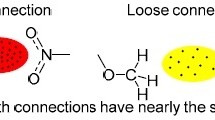Abstract
Density functional theory calculations were performed on crystalline 2,6-diamino-3,5-dinitropyridine-1-oxide (ANPyO). The conduct bands are generally quite flat, while the valence bands are uneven. The carbon, oxygen and amino nitrogen atoms make up the narrow lower energy levels. While the carbon, amino nitrogen and atoms in nitro group make up the higher energy levels. Change of electronic charges for the decrease of the cell edge a and c are almost the same, but different from the decrease of the cell edge b, indicating an anisotropic effect related to compressions. The C-Nitro and the N–O (N-oxide) bonds are the weakest, and tend to rupture upon external stimulation. The Mulliken population for the N–O (N-oxide) bond in crystal is much smaller than that in molecule, indicating that the molecular packing weakens this bond. Judged by the fact of N–O (N-oxide) bond being weaker than C-Nitro bond, ANPyO is sensitive to mechanic impact than 1,3,5-triamino-2,4,6-trinitrobenzene, which is in good agreement with experiment. The crystal lattice energy is predicted to be −166.03 kJ/mol, after being corrected for basis set superposition error.




Similar content being viewed by others
References
Anderson KL, Merwin LH, Wilson WS, Facelli JC (2002) 15N chemical shifts in energetic materials: CP/MAS and ab initio studies of aminonitropyridines, aminonitropyrimidines, and their N-oxides. Int J Mol Sci 3:858–872
Li JS, Huang YG, Dong HS (2004) Theoretical prediction of properties of polynitropyridines and their N-oxides. Chin J Energ Mater 12:576–579
Li JS, Huang YG, Dong HS, Yang GC (2003) Density functional theory study on polynitropyridines. Chin J Energ Mater 11:178–180
Cheng J, Yao QZ, Zhou XL, Du Y, Fang D, Liu ZL (2008) Novel synthesis of 2,6-diamino-3,5-dinitropyridine-1-oxide. Chin J Org Chem 28:1943–1947
Pagoria PF, Lee GS, Mitchell AR (2002) A review of energetic materials synthesis. Thermochim Acta 384:187–204
He ZW, Cheng J, Liu ZL (2009) Refine and properties of 2, 6-diamino-3, 5-dinitropyridene-1-oxide. Chin J Energ Mater 17:392–395
Zhang XH, Ding LX, Zhu GJ (1997) Preparation methods of explosive in the lab. National Defense Industrial Press, Beijing
Miao YL, Zhang TL, Qiao XJ, Zhang JG, Yu RG, Yu KB (2003) Characterization and crystal structure of 2, 6-diamino-3, 5-dinitropyridine-1-oxide. Chin J Explos Propellents 26:37–40
Jadeja RN, Shirsat RN, Suresh E (2005) Ab initio study and its comparison with X-ray crystal structure of 4-[1-(4-Chloro-phenylamino)-ethyl] 5-methyl-2-p-tolyl-2, 4-dihydro-pyrazol-3-one. Struct Chem 16:515–520
Hollins RA, Nissan RA, Wilson WS, Gilardi RD (1995) 2,6-Diamino-3,5-dinitropyridine-1-oxide: a new insensitive explosive. NAWCWPNS Technical Publication, China Lake, CA
Segall MD, Lindan PJD, Probert MJ, Pickard CJ, Hasnip PJ, Clark SJ, Payne MC (2002) First-principles simulation: ideas, illustrations and the CASTEP code. J Phys 14:2717–2743
Saunders VR, Dovesi R, Roetti C, Causà M, Harrison NM, Orlando R, Zicovich-Wilson CM (1998) Crystal 98. University of Torino, Torino, Italy
Monkhorst HJ, Pack JD (1976) On special points for Brillouin zone integrations. Phys Rev B 13:5188–5192
Boys SF, Bernardi F (1970) The calculation of small molecular interactions by the differences of separate total energies, some procedures with reduced errors. Mol Phys 19:553–559
Frisch MJ, Trucks GW, Schlegel HB, Scuseria GE, Robb MA, Cheeseman JR, Montgomery JA, Jr Vreven T, Kudin KN, Burant JC, Millam JM, Iyengar SS, Tomasi J, Barone V, Mennucci B, Cossi M, Scalmani G, Rega N, Petersson GA, Nakatsuji H, Hada M, Ehara M, Toyota K, Fukuda R, Hasegawa J, Ishida M, Nakajima T, Honda Y, Kitao O, Nakai H, Klene M, Li X, Knox JE, Hratchian HP, Cross JB, Adamo C, Jaramillo J, Gomperts R, Stratmann RE, Yazyev O, Austin AJ, Cammi R, Pomelli C, Ochterski JW, Ayala PY, Morokuma K, Voth GA, Salvador P, Dannenberg JJ, Zakrzewski VG, Dapprich S, Daniels AD, Strain MC, Farkas O, Malick DK, Rabuck AD, Raghavachari K, Foresman JB, Ortiz JV, Cui Q, Baboul AG, Clifford S, Cioslowski J, Stefanov BB, Liu G, Liashenko A, Piskorz P, Komaromi I, Martin RL, Fox DJ, Keith T, Al-Laham MA, Peng CY, Nanayakkara A, Challacombe M, Gill PMW, Johnson B, Chen W, Wong MW, Gonzalez C, Pople JA (2003) Gaussian 03 Revision B 03. Gaussian, Inc, Pittsburgh, PA
Hoffmann R (1988) Solids and surfaces: a chemist’s view of bonding in the extended structures. VCH Publishers, New York
Kortus J, Pederson MR, Richardson SL (2000) Density functional-based prediction of the electronic, structural, and vibrational properties of the energetic molecules: octanitrocubane. Chem Phys Lett 322:224–230
Mulliken RS, Ermler WC (1977) Diatomic molecules: results of ab initio calculations. Academic, New York, pp 33–38
Reed AE, Weinstock RB, Weinhold F (1985) Natural population analysis. J Chem Phys 83:735–746
Dovesi R, Causa M, Orlando R, Roetti C (1990) Ab initio approach to molecular crystals: a periodic Hartree-Fock study of crystalline urea. J Chem Phys 92:7402–7411
Ju XH, Xiao HM, Xia QY (2003) A density functional theory investigation of 1,1-diamino-2,2-dinitroethylene dimers and crystal. J Chem Phys 119:10247–10255
Kim KS, Tarakeshwar P, Lee JY (2000) Molecular cluster of π-systems: theoretical studies of structures, spectra, and origin of interaction energies. Chem Rev 100:4145–4186
Gibbs TR, Popolato A (1980) LASL explosive property data. University of California Press, Berkeley
Acknowledgements
We gratefully thank the National Natural Science Foundation of China (Grant 10576030) and the Postgraduate Innovation Project of Jiangsu Province for partial financial support.
Author information
Authors and Affiliations
Corresponding authors
Rights and permissions
About this article
Cite this article
He, ZW., Zhou, SQ., Ju, XH. et al. Computational investigation on 2,6-diamino-3,5-dinitropyridine-1-oxide crystal. Struct Chem 21, 651–656 (2010). https://doi.org/10.1007/s11224-010-9594-x
Received:
Accepted:
Published:
Issue Date:
DOI: https://doi.org/10.1007/s11224-010-9594-x




